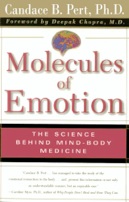feelings


sensing ourselves
Everyone knows that they can close their eyes, raise their arm, and sense that it is indeed raised. We have what is called “proprioceptors” -- inner receptors that sense pressure and tension among our body parts. We sense hunger, thirst, a full bladder... and we also sense much subtler inner changes. Indeed, everything we do sense is part of ourselves, what we see is an inner sensation triggered by what happens in our eyes, what we hear is an inner sensation triggered by what happens in our ears. We will discuss this more deeply in the Unit on Cognition. For now, I wish to point out that we sense molecular level changes in our bodies.
molecules of emotion
Dr. Candace Pert was working on receptors. Receptors is a term applied to the surface in a body that is appropriately configured so that a molecule that encounters that surface triggers a change that may cascade as a series of further changes that alter our internal structure, however subtly. These changes are sometimes sensed and sometimes not; and in part whether or not we sense them depends on whether we have learned to direct our attention to the possibilities within us.


In any case, Dr. Pert was looking for where in the body opium receptors might be found. Opium, or any other drug, cannot have an effect on the body if there is no place for it to connect at a molecular level. (Antibiotics work one removed, they in principle affect only other organisms in our body, which in turn affect us.)
In her book, published some years after this research, Dr. Pert eloquently describes how she found the opium receptors, not only in the brain as expected, but much more abundantly on the lining of the gut. She likes to quip that we quite literally have “gut feelings.” Further, she goes on to show that there are literally nearly 100 different naturally produced molecules that move in the body and alter how we feel. These are known as “neuropeptides” ... and what we have found so far may not represent all that matter.
We do not need large numbers of these molecules to trigger responses, indeed as for the single celled bacterium to change what it does, quickly and reversibly, most of these inner molecular changes are subtle and short lived; and hence hard to detect. Indeed, homeotherapy could not work as it does if large dosages of molecules were required to affect some of the changes we desire.
I like to speak of this as a scintillating, flickering, constellation of coherent changes
scent
